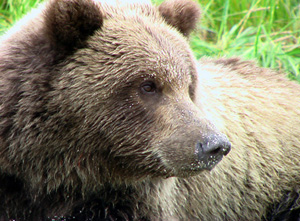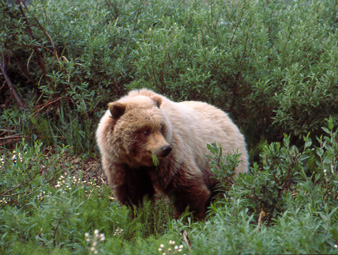History of Grizzly Bears in the North Cascades

Before Europeans arrived, grizzly bears were thriving throughout most of western North America. Hudson Bay Company trapping records show almost 4,000 grizzly bear hides shipped from trading posts in or near the North Cascades from 1827 and 1859.
Today, it is estimated that only 20 to 40 grizzly bears remain in the North Cascades of Washington and British Columbia. This steep population decline is attributed to commercial trapping, habitat loss, and unregulated hunting. An isolated population, a restricted gene pool, and a very slow reproductive rate will make it almost impossible for North Cascade grizzly bears to recover naturally.
Preliminary steps have been taken toward grizzly bear recovery in the US North Cascades. The grizzly bear was listed as Threatened under the US Endangered Species Act in 1975. The US Fish and Wildlife Service (USFWS) designated the North Cascades as one of six recovery areas in the lower 48 states. Protection for grizzly bears has been built into federal land management plans (e.g., National Forest Plans). Important steps have also been taken to reduce non-natural food attractants for bears (i.e., garbage, birdfeed, pet food, and other foods that attract bears to residential areas). Opinion surveys have demonstrated that a strong majority of residents in and around the North Cascades support grizzly bear recovery. Everything is ready to go in the Washington North Cascades, but the process has stalled at the federal level.
During the past decade, British Columbia has moved ahead of the US on grizzly bear recovery in the North Cascades by planning and partially implementing an augmentation program using bears from Wells Gray Provincial Park. The augmentation effort has been put on hold by the BC Ministry for the Environment. The delay has been attributed to concerns about the effectiveness of grizzly bear augmentation programs.
Grizzly Bear Advocacy Today
Further progress on grizzly bear conservation in the Washington North Cascades requires an Environmental Impact Study (EIS). Federal funding is needed for the USFWS to implement the EIS. The USFWS recognizes the need for an EIS, but states that EIS funding is precluded by necessary spending on other endangered species.

The Washington Congressional delegation, the USFWS, and other partners need to work together to generate funding for this critical study that will resolve how grizzly bear conservation should proceed in the Washington North Cascades.
Only limited steps are being taken by the Washington Department of Fish and Wildlife (WDFW) to recover the North Cascades grizzly bear population. The Washington State Legislature has allocated $454,000 toward implementation of a federal EIS, but these funds can not be expended until the USFWS takes action. WDFW needs to increase their grizzly bear conservation efforts and Washington State legislators need to continue their call for grizzly bear conservation (renew future funding for the EIS) until the USFWS finally hears that Washington residents really want grizzly bears in the North Cascades.
Here is a letter we sent to WDFW’s Director:
Recent discussions among the North Cascades Subcommittee of the Interagency Grizzly Bear Committee indicate that after 20 years there may be some progress toward grizzly bear recovery in the North Cascades Ecosystem. North Cascades Conservation Council strongly supports the restoration of grizzly bears throughout the North Cascades Ecosystem, with the North Cascades National Park Complex as the anchor of this area.
Grizzly bears were once quite prevalent and widely distributed throughout the greater Pacific Northwest. Although nobody seems to know for sure how many grizzly bears now roam the Cascades, one thing is certain – there are precious few. With the return of the gray wolf, increased wolverine appearances in the Cascades and your Department’s outstanding effort to restore Pacific fishers to the state, the grizzly bear alone remains without a plan – or a future in the Cascades.
Besides enhancing the resilience of the species, there are many reasons to save grizzly bears in the North Cascades. As a species with large area requirements grizzly bears may be considered an umbrella species, the conservation of which will benefit other species. The grizzly is a western icon with strong public support, symbolic of our independence, toughness and love of wildness. Grizzly bears epitomize and safeguard wilderness. Perhaps most importantly, our legacy must be one of conservation and restoration, not extinction.
To allow these animals to become extirpated from this region is not only ecologically unwise but morally wrong. We have the habitat and the resources, and a highly educated supportive public to help realize grizzly bear recovery in this area.
There are no excuses for continued inaction. When we recover grizzlies, future generations will be grateful for our vision. Action now will help us retain the wild heart of our magnificent North Cascades for decades to come. We cannot wait any longer before moving forward on this vital recovery effort.
There are enthusiastic partners in a grizzly bear recovery effort. The National Park Service has dedicated $640,000 towards an Environmental Impact Statement on grizzly bear recovery. Also, the bi-national Skagit Environmental Endowment Commission has dedicated at least a quarter of a million dollars for the same purpose. But those funds won’t remain in the bank forever. Agency partners like the USFS have also pledged in-kind support for the recovery process.
We understand the DFW mission is sometimes very difficult to realize. But since Americans have been unflagging in their support for our irreplaceable wildlife heritage, we are confident that the majority of the public will support a grizzly bear recovery effort. Helping to guide the recovery of such a charismatic animal is a uniquely American privilege that our communities would embrace.
We urge you to provide leadership and allow the public process to proceed through an Environmental Impact Statement that could help guide grizzly bear recovery in the North Cascades. Let’s put our democratic process to work for the grizzly bear and our communities.
The British Columbia Ministry for the Environment also needs to restart its augmentation program that will bring additional grizzly bears into the BC North Cascades. Research publications have clearly documented that grizzly bear augmentation programs are successful if young females are placed into areas with adequate habitat and food.
